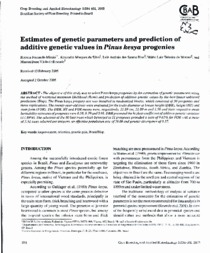Estimates of genetic parameters and prediction of additive genetic values in Pinus kesya progenies.
Estimates of genetic parameters and prediction of additive genetic values in Pinus kesya progenies.
Author(s): MISSIO, R. F.; SILVA, A. M. da; DIAS, L. A. dos S.; MORAES, M. L. T. de; RESENDE, M. D. V. de
Summary: The objeetive ofthis study was to seleet Pinus kesya prog enies by lhe estimation of g enetic p arameters using lhe method of restricted maximum likelihood (Remi) and prediction of additive genetic values by the best linear unbiased prediction (Blup ). The Pinus kesya progeny tesl was installed in randomized b/oeks. which consist ed of 30 progenies and three replications. Tlze twenty-year-old trees were evaluated for lhe traits diameter at breast heiglit (DBH), height (HT) and st em form (FOR). The DBH, HT and FOR means \Vere, respectively, 21.89 em, 21.89111 and 1.56 and their respective mean herit ability estimares of progenies were 0.58, 0.39 and 0.66. DBH presented the highest coefficient of additive genetic variation (17.89%). Tlze selection ofthe 80 best t rees whicli belon ged 1021 progenies provided a gain 0/,9.62%for FOR witli a mean of 3.81 trees selected per prog eny, an effective population si:e 0/,30.86 and g enetic diverg ence ofO.37.
Publication year: 2005
Types of publication: Journal article
Unit: Embrapa Forestry
Keywords: Ganho genético, Genetic gain, Improvement, Parâmetro Genético, Pinus kesya, Progênie, Reml/Blup, Selection
Observation
Some of Embrapa's publications are published as ePub files. To read them, use or download one of the following free software options to your computer or mobile device. Android: Google Play Books; IOS: iBooks; Windows and Linux: Calibre.
Access other publications
Access the Agricultural Research Database (BDPA) to consult Embrapa's full library collection and records.
Visit Embrapa Bookstore to purchase books and other publications sold by Embrapa.

